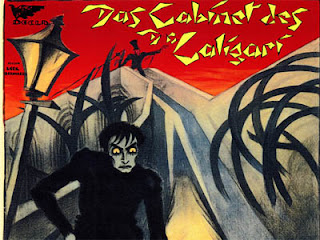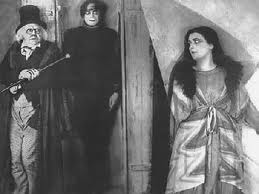A cunningly deceptive silent film, it follows the reconstruction of Francis’ (Friedrich Feher) tale to a stranger about a sinister doctor and the attempted murder of his betrothed, Lil (Jane Olsen). The film opens with Francis and the stranger in a small enclosed garden, when Francis’ betrothed passes by, caught up in her own world oblivious to the two men. Francis begins to talk to the stranger about Lil, drawing the audience into an imaginary world. “The film opens in the German town of Holstenwall, seen in a drawing as houses like shrieks climbing a steep hill. After a prologue, a story is told: A sideshow operator named Caligari Werner Krauss arrives at the fair to exhibit the Somnambulist”
The town of Holstenwall is depicted by a cartoon-like set, with thick heavy obscure lines defining every object. The style and feel of the sets are similar to Frank Miller’s Sin City or the Saint. If Frank Miller was around in the 20s he would have made films like this and for Robert Wiene (director of, The Cabinet of Dr.Caligari) vice-a-versa. Doctor Caligari enters the local authority to apply for a concessionary licence for a stall in a fair, looking timid and withdrawn the doctor waits patiently in a bright room that gives the illusion it was bigger than it really was, which highlighted his demeanor. After receiving his licence we see the doctor outside a tent touting for an audience to see his Somnambulist (sleepwalker) who has been sleeping for 25 years. After drumming up enough business the scene changes to the interior of the tent. This is bigger than the previous interior shot, but is darker which gives it a more enclosed look. From here the film becomes claustrophobic, although the definition of the props and scenes were obvious, they were nevertheless presented as over exaggerated, twisted, elongated and generally deformed. The question is why was the depiction of his world so simple and incoherent. The film continues with the unveiling of Cesare (Conrad Veidt) the sleepwalker, with the doctor professing his ability to prophecies the future and welcoming the audience to seek his predictions. Alan (Hans Heinrich Von Twardoski) an old friend of Francis, does by asking “how long will I live” the reply being, "you will die at Dawn". Alan totally taken aback by this news stumbles out of the tent.
He and Francis are next seen walking Lil home along a street very much constructed in the same fashion still very confined and minimalist. Alan is murdered at dawn as predicted by the sleepwalker, drawing the town to a standstill, as Francis and the authorities search for the perpetrator. The focus is now on the police station, defined by numerous stairs at the entrance and an interior with only a table and two elongated chairs, with two uniformed officers leaning over the table. The room is darkly lit with a dingy appearance, a very sparse room with nothing in it to define it as a police station. Doctor Caligari’s home is much smaller and moodily lit, and in the corner the sleepwalker’s cabinet is positioned on the wall which highlights the doctor’s sinister persona.
The camera pans between these two scenes as the search for the killer continues. As the tension rises the darker and gloomier the scenes become, with the obvious use of lights to emphasise the atmosphere. In stark contrast Lil’s bedroom is well lit and spacious, with tall angled windows and a sense of calm, but this is short lived when the sleepwalker breaks in and abducts her.
However, her screaming is not in vain, as police and town’s folk follow the Sleepwalker up and across the brightly lit townscape crudely depicted through a simple but effective design that portrays an airy atmosphere managed with the use of lighting, giving a Sin City feel to it. However, the town’s folk are not giving up and continue to chase him until the sleepwalker reaches a oddly depicted bridge where he drops Lil and proceeds to collapse dead in front of her.
“The amazing style of this film first lured me in with its funhouse-feel of its design. A very eerie, stylized funhouse, that is.” The bridge is a typical funhouse scene, which is boldly depicted in a cartoon-like fashion not knowing when shadow ends and exaggerated painting and props begin. While the authorities deal with the sleepwalker, Francis pursues the doctor to an asylum, a large building shrouded in darkness which seems to stand alone in the night. Francis on meeting other doctors at the entrance convinces them to investigate Caligari, who is also the head doctor of the asylum. They find in his office a book on an infamous doctor also named Caligari, who tours the country with his sleepwalker ordering him to prophesy and kill his victims. When the doctors learn of this information they bind Caligari and detain him in the asylum. The film begins to wind down, and still there is no explanation to the meaning behind the crudely drawn child-like cartoon sets and the mood driven atmosphere. “Overall, the plot seems almost stagnant, as if it has nothing new to offer. It seems obvious from early in the film that Caligari is controlling Cesare in order to commit these murders. It’s hardly a surprise when Cesare attacks Jane, the only pretty woman on the screen available for damsel-in-distress duty” This is true, and if not for the twist at the end the outcome of this film would have been much different. The film reverts back to Francis and the stranger in the garden; they begin to walk out of the garden into a square outside the asylum, which looks a lot less intimidating and gloomy, where his betrothed Lil is seated in the middle on a throne surrounded by mental patients. What’s going on? Francis points out the sleepwalker amongst the crowd of patients, but is he not dead? The stranger walks away from Francis with no reply, giving confused glances over his shoulder as he leaves. Francis approaches his betrothed and asks her “will you marry me”, to which she replied “we of royal blood cannot have what the heart wants”. The film becomes clear - Francis is mad, his betrothed Lil is mad also, all the mad people in his tale are really sane, and the sane people, including himself are mad. Fantastic, this explains the reasoning behind the sets, the simplistic but bold re-creation of a mad mans mind using swirls and incoherent lines in his story telling, but when back in reality we start to see straight lines and a more constant use of lighting. The doctor, who turns out to be a reputable practitioner, was being portrayed as the infamous Caligari, a mythical character. A Film worth seeing if not for its vivid depiction of the insane mind, but for the reassuring twist at the end.






No comments:
Post a Comment